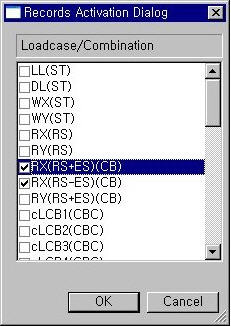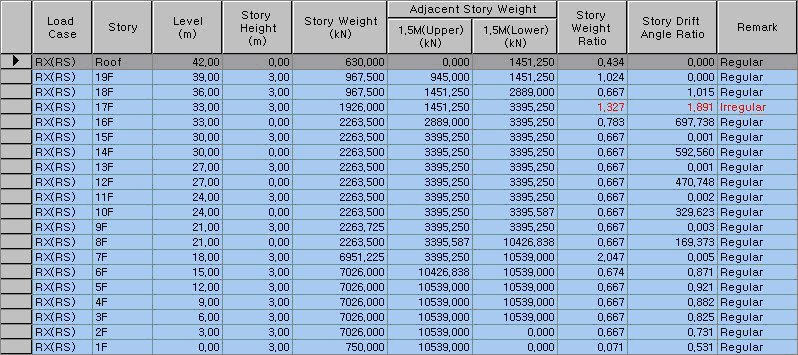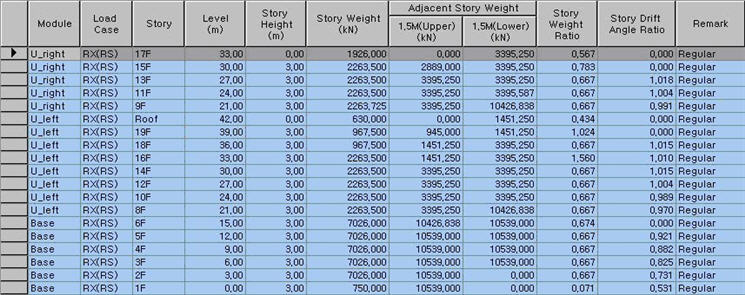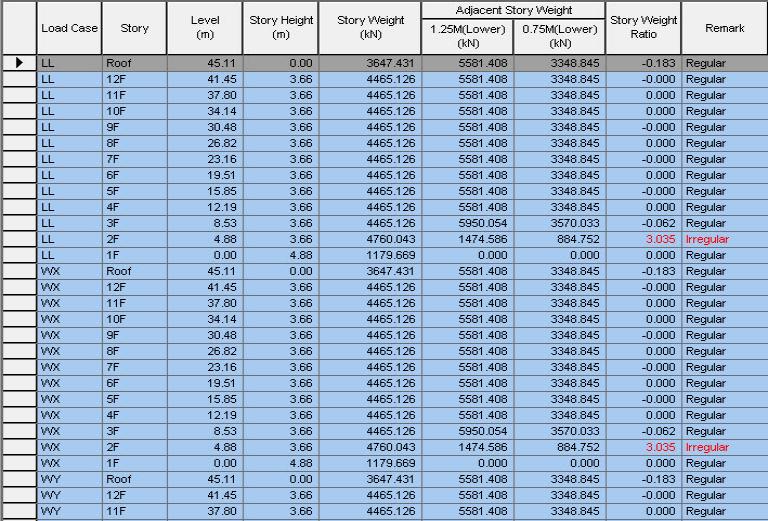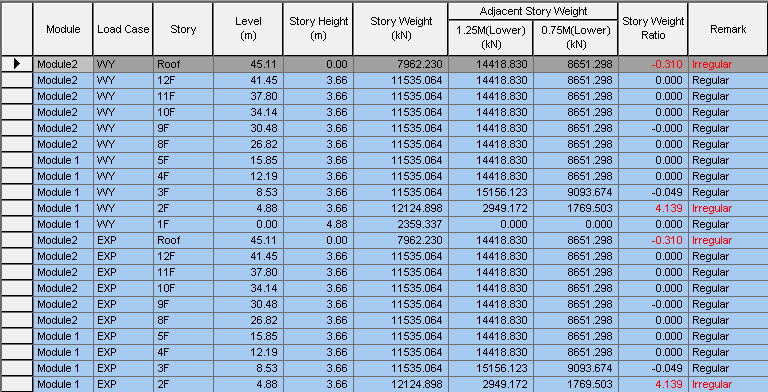Weight Irregularity Check Table
|
|
|
|
|
|
Effective weights of a story and an adjacent story are calculated, and the regularity of weight distribution is checked and tabulated in a spread sheet format.
When "Story Shear Force Ratio>Consider Story Module" is checked in the "Model/Building/Control Data", accurate shear forces can be obtained for the story having the overlapping Module.
When Modules are defined in Results > Result Tables > Story > Define Module, the Module data is displayed in the first column of the table.
When the ratios exceed the allowable limit, they appear in red and “Irregular” is printed in the Remark.
Table Tool in MIDAS/Gen offers a variety of powerful built-in functions.
Refer to the following items for detail directions: Usage of Table Tool
Terminology
Familiarize with Usage
Basic directions (Cell motion, selection, size control, etc.)
Data manipulation (Add, delete, modify data, etc.)
Copy/Paste data using clipboard
Supplementary Table functions
Table Sorting
Table format setting
Auto-fit column width
Graph printing
Supplementary functions by Table types
Node/Element Table
Results Table |
|
|
|
|
|
|
|
From the Main Menu select Results > Result Tables > Story > Weight Irregularity Check Table
Select Result Tables > Story > Weight Irregularity Check Table in the Tables tab of the Tree Menu. |
|
|
|
|
|
From Record Activation Dialog, select the load cases/combinations for which Weight Irregularity will be checked. Story Weight is the same irrespective of a loading condition. The reason for entering load cases here is to check if the lateral drifts of two consecutive stories differ by more than 130%. If it is less than 130%, Weight Irregularity need not be considered.
Record Activation dialog box
Refer to Usage of Table Tool and check the following data:
1.When Modules are not defined .
Load Case: Load case/Combination
Story: Story ID
Level: Story Elevation
Height: Story Height
1. Story Weight
Story Weight is calculated from Story Mass (Additional Mass included) from Query multiplied by the acceleration of gravity.
Note
1
2. Adjacent Story Weight
1.5 M(Upper): Story Weight of the story immediately above the current story is multiplied by 1.5
1.5 M(Lower): Story Weight of the story immediately below the current story is multiplied by 1.5
3. Story Weight Ratio
Story Weight Ratio: "Story Weight" / ("Adjacent Story Weight " – smaller of two values)
4. Story Drift Angle Ratio
Story Drift Angle Ratio: "Story Drift Angle at a current story" / " Story Drift Angle at the story above the current story"
5. Remark
If Story Weight Ratio exceeds 1.0 and Story Drift Angle Ratio exceeds 1.3, "Irregular" is printed, otherwise, "Regular" is printed. (If "Story Drift Angle Ratio" does not exceed 1.3, "Regular" is printed irrespective of the "Story Weight Ratio".)
When Modules are defined
The Module column is generated only when the Modules are defined. Weight irregularity check results are generated as per the following Note.
Module: Module name is defined in Define Module
Load Case: Load case/Combination
Story: Story ID
Level: Story Elevation
Height: Story Height
1. Story Weight
Story Weight is calculated from Story Mass (Additional Mass included) from Query multiplied by the acceleration of gravity.
Note 1 Additional mass for the 1st floor is not reflected in the weight irregularity check.
2. Adjacent Story Weight
1.5 M(Upper): Story Weight of the story immediately above the current story is multiplied by 1.5
1.5 M(Lower): Story Weight of the story immediately below the current story is multiplied by 1.5
3. Story Weight Ratio
Story Weight Ratio: "Story Weight" / ("Adjacent Story Weight " – smaller of two values)
4. Story Drift Angle Ratio
Story Drift Angle Ratio: "Story Drift Angle at a current story" / " Story Drift Angle at the story above the current story"
5. Remark
If Story Weight Ratio exceeds 1.0 and Story Drift Angle Ratio exceeds 1.3, "Irregular" is printed, otherwise, "Regular" is printed. (If "Story Drift Angle Ratio" does not exceed 1.3, "Regular" is printed irrespective of the "Story Weight Ratio".)
For NTC 2008
1.When Modules are not defined .
Load Case: Load case/Combination
Story: Story ID
Level: Story Elevation
Height: Story Height
1. Story Weight
Story Weight is calculated from Story Mass (Additional Mass included) from Query multiplied by the acceleration of gravity.
Note
2. Adjacent Story Weight
1.25M(Lower): Story Weight of the story immediately below the current story is multiplied by 1.25
0.75M(Lower): Story Weight of the story immediately below the current story is multiplied by 0.75
3. Story Weight Ratio
Story Weight Ratio for nth story= (Mn-Mn-1)/Mn-1 , where Mn is the story weight of the nth story
4. Remark
If -0.25<Story Weight Ratio<0.25 , "Regular" is printed, otherwise, "Irregular" is printed.
Note: When the story weight of a particular story is bigger than 1.25 times or lower than 0.75 times the weight of the story below, then the story will be defined as irregular.
When Modules are defined
The Module column is generated only when the Modules are defined. Weight irregularity check results are generated as per the following Note.
Module: Module name is defined in Define Module
Load Case: Load case/Combination
Story: Story ID
Level: Story Elevation
Height: Story Height
1. Story Weight
Story Weight is calculated from Story Mass (Additional Mass included) from Query multiplied by the acceleration of gravity.
Note 1 Additional mass for the 1st floor is not reflected in the weight irregularity check.
2. Adjacent Story Weight
1.25 M(Lower): Story Weight of the story immediately below the current story is multiplied by 1.25
0.75 M(Lower): Story Weight of the story immediately below the current story is multiplied by 0.75
3. Story Weight Ratio
Story Weight Ratio for nth story= (Mn-Mn-1)/Mn-1 , where Mn is the story weight of the nth story
4. Remark
If -0.25<Story Weight Ratio<0.25 , "Regular" is printed, otherwise, "Irregular" is printed.
Note: When the story weight of a particular story is bigger than 1.25 times or lower than 0.75 times the weight of the story below, then the story will be defined as irregular.
|
|
|
